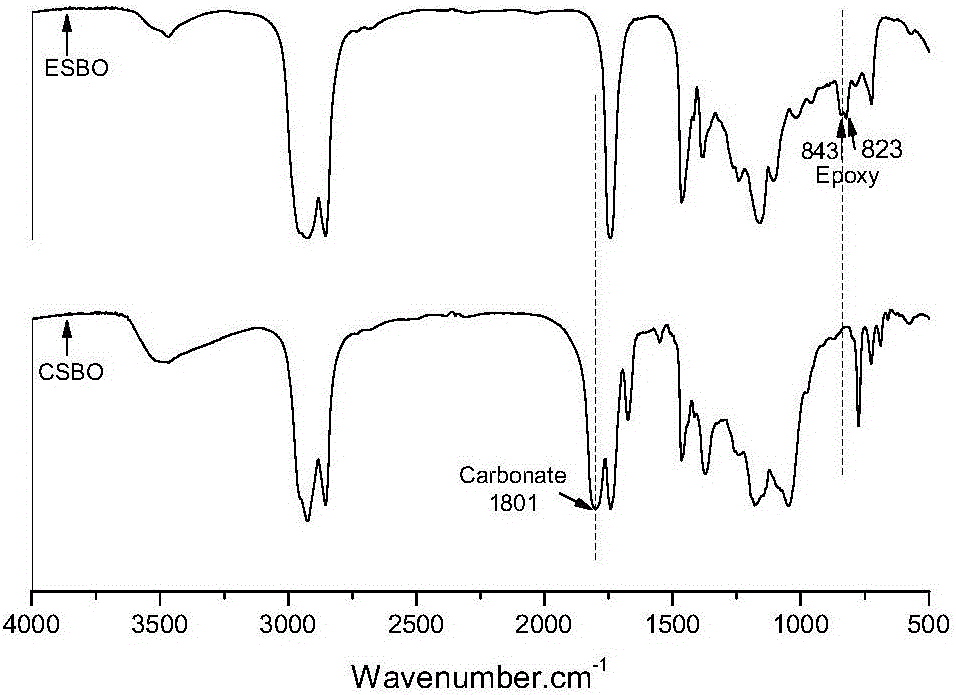Method for preparing hybrid non-isocyanate polyurethane by carbon dioxide
A non-isocyanate and carbon dioxide technology is applied in the field of preparing hybrid non-isocyanate polyurethane, which can solve the problems of unsatisfactory mechanical properties of NIPU, and achieve the effects of improving comprehensive mechanical properties and simple preparation process.
- Summary
- Abstract
- Description
- Claims
- Application Information
AI Technical Summary
Problems solved by technology
Method used
Image
Examples
Embodiment 1
[0043] Step 1 adds epoxidized soybean oil (ESBO) 100g in 0.5L autoclave, dimethylformamide 30g, macroporous resin supports tetrabutylammonium bromide catalyst 15g, opens stirring device with 0.5MPa CO 2 Replace the air in the kettle for 5 times, then start heating to 130°C, react for 50 hours, and keep the CO in the kettle 2 The pressure is 1.0MPa until the end of the reaction, and then the temperature is lowered to empty the unreacted CO 2 Gas, discharge. After the reaction, the feed liquid was filtered to separate the catalyst. The filtrate was distilled under reduced pressure at 70-110°C, and the solvent dimethylformamide was removed to obtain a light yellow transparent liquid cyclocarbonate (CSBO-1#) product. Sample analysis showed that the conversion rate of ESBO was 59.8%.
[0044] Step 2 adds bisphenol A epoxy resin (E54) 100g in 0.5L autoclave, dimethylformamide 100g, macroporous resin supports tetrabutylammonium bromide catalyst 15g, opens stirring device with 0.5MP...
Embodiment 2
[0048] Step 1 adds epoxidized soybean oil (ESBO) 100g in 0.5L autoclave, dimethylacetamide 50g, macroporous resin supports tetramethylammonium iodide catalyst 10g, opens stirring device with 0.5MPa CO 2 Replace the air in the kettle 5 times, then start heating to 160°C, react for 40 hours, and keep the CO in the kettle 2 The pressure is 2.0MPa until the end of the reaction, and then the unreacted CO is evacuated by cooling down 2 Gas, discharge. After the reaction, the feed liquid was filtered to separate the catalyst. The filtrate was distilled under reduced pressure at 70-110° C., and the solvent dimethylacetamide was removed to obtain a light yellow transparent liquid cyclocarbonate (CSBO-2#) product. Sample analysis showed that the conversion rate of ESBO was 100%.
[0049] Step 2 adds epoxy resin (E54) 100g in 0.5L autoclave, dimethylacetamide 50g, macroporous resin supports tetramethylammonium iodide catalyst 10g, opens stirring device with 0.5MPa CO 2 Replace the air...
Embodiment 3
[0053] Step 1 adds epoxidized soybean oil (ESBO) 100g in 0.5L autoclave, dimethyl sulfoxide 100g, macroporous resin supports tetrabutylammonium bromide catalyst 5g, opens stirring device with 0.5MPa CO 2 Replace the air in the kettle for 5 times, then start heating to 150°C, react for 40 hours, and keep the CO in the kettle 2 The pressure is 3.0MPa until the end of the reaction, and then the unreacted CO is evacuated by cooling down 2 Gas, discharge. After the reaction, the feed liquid was filtered to separate the catalyst. The filtrate was distilled under reduced pressure at 70-110° C., and the solvent dimethyl sulfoxide was removed to obtain a light yellow transparent liquid cyclocarbonate (CSBO-3#) product. Sample analysis showed that the conversion rate of ESBO was 96.8%.
[0054] Step 2 adds epoxy resin (E54) 100g in 0.5L autoclave, dimethyl sulfoxide 30g, macroporous resin supports tetrabutylammonium bromide catalyst 5g, opens stirring device with 0.5MPa CO 2 Replace ...
PUM
| Property | Measurement | Unit |
|---|---|---|
| Tensile strength | aaaaa | aaaaa |
| Tear strength | aaaaa | aaaaa |
| Tensile strength | aaaaa | aaaaa |
Abstract
Description
Claims
Application Information
 Login to View More
Login to View More - R&D
- Intellectual Property
- Life Sciences
- Materials
- Tech Scout
- Unparalleled Data Quality
- Higher Quality Content
- 60% Fewer Hallucinations
Browse by: Latest US Patents, China's latest patents, Technical Efficacy Thesaurus, Application Domain, Technology Topic, Popular Technical Reports.
© 2025 PatSnap. All rights reserved.Legal|Privacy policy|Modern Slavery Act Transparency Statement|Sitemap|About US| Contact US: help@patsnap.com



